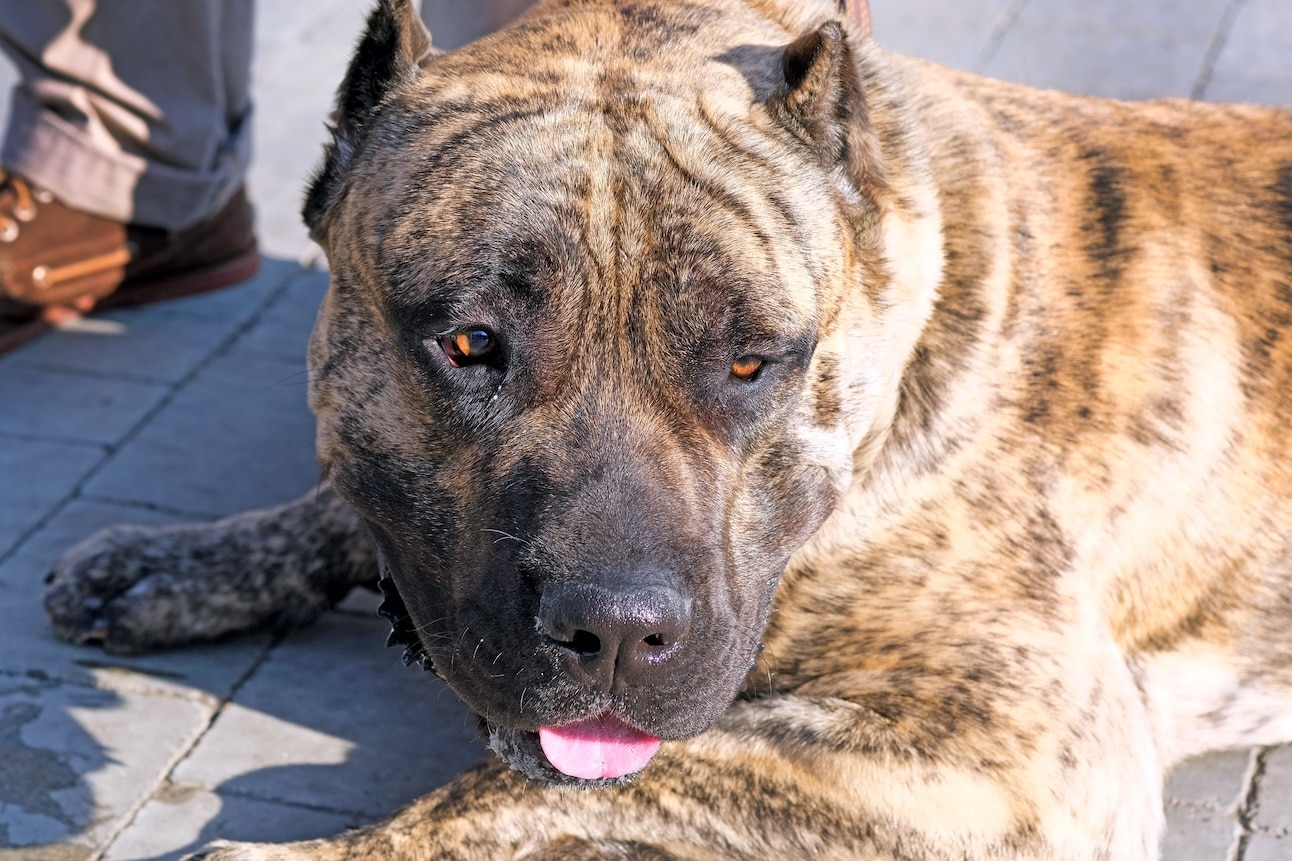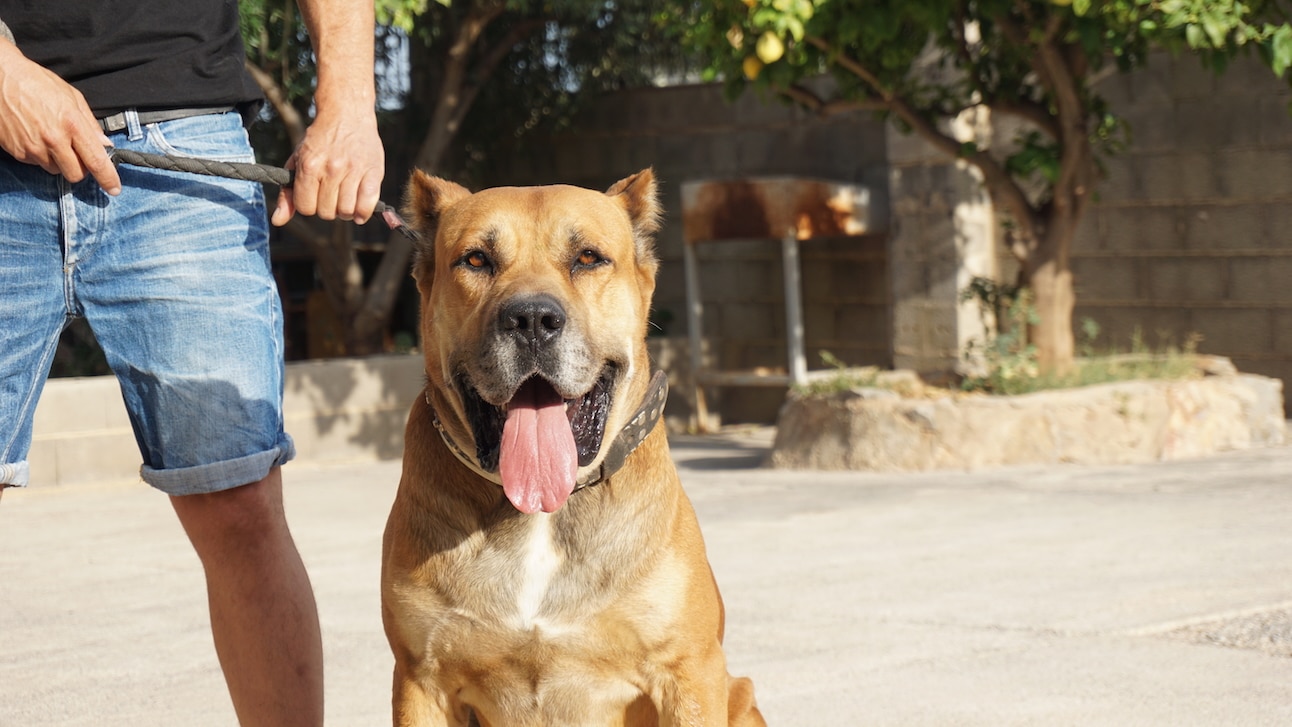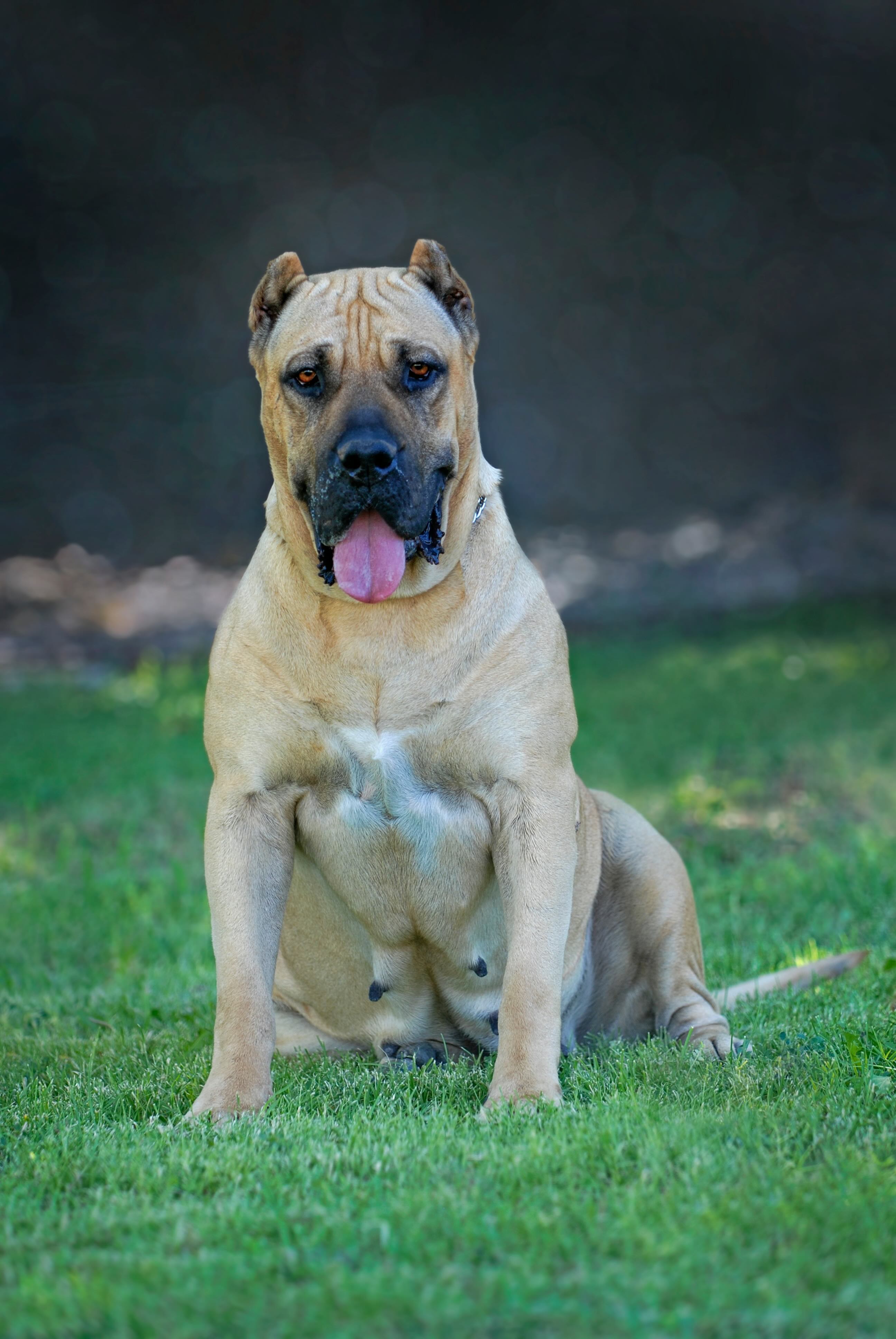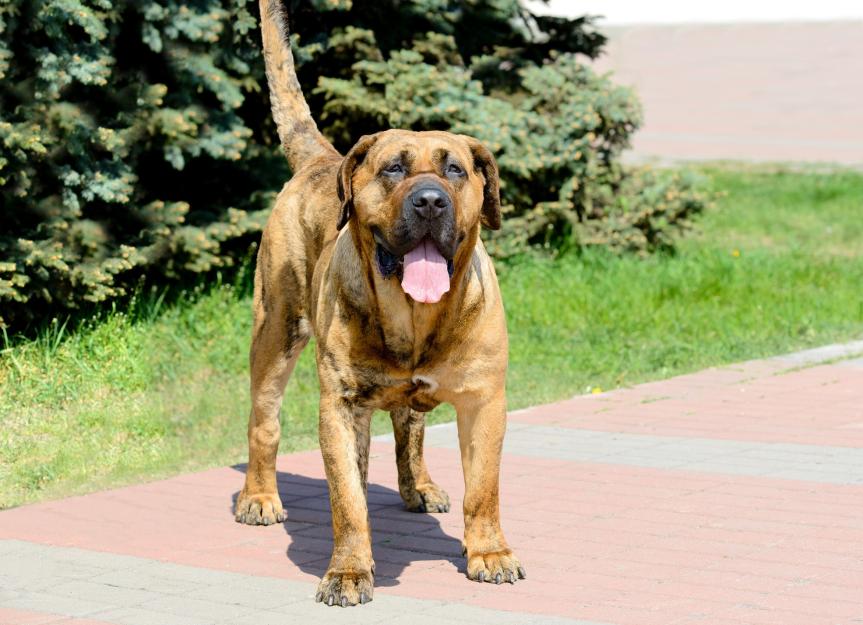The Presa Canario (also called the Perro de Presa Canario) is a mastiff-type dog with a serious look to match the serious work they’ve performed for hundreds of years.
Originating from the Canary Islands of Tenerife and Gran Canaria, and sometimes referred to as Canary dogs or Canary Mastiffs, the Presa Canario’s mental and physical strength have long made them a prized pick for herding and guarding cattle.
The breed standard describes Presa Canarios as having a balanced temperament: confident and a little distant but also docile, obedient, and devoted to their families. Noble in both character and appearance, the dogs range 84–110 pounds, are longer than they are tall, and sport an enormous head with a characteristic black mask and enormous jowls.
Literally and figuratively thick-skinned, Presa Canarios are vigilant dogs who stand firm and focused with an endearingly furrowed brow when alert.
Caring for a Presa Canario

While the Presa Canario has traditionally been a working dog, that doesn’t mean the breed can’t transition to family life. However, what makes them perfect for cattle work demands careful consideration for prospective pet parents.
Presa Canarios are usually wary of strangers and closely bonded to their families: characteristics that make them ideal livestock guardians, notes the Presa Canario Club of America (PCCA). However, these attributes also mean they may not be the best choice for multi-pet households due to their strong prey drive.
According to the PCCA, Presa Canarios thrive in homes that can provide plenty of attention and consistent guidance. And while they’re fairly low energy, the breed still needs daily exercise to keep their mind and body in good shape.
Presa Canario Health Issues
The Presa Canario is considered a generally healthy breed with an average lifespan of 9–11 years. However, like all breeds, they are predisposed to certain health conditions.
Hip Dysplasia
Hip dysplasia is a condition in which the hip joint doesn’t develop properly, causing joint instability that leads to arthritis in your dog if left untreated.
Mild cases are treated with interventions like weight loss, physical therapy, joint supplements, and anti-inflammatory drugs, but severe cases may require corrective surgery.
Common signs of hip dysplasia include:
Elbow Dysplasia
Elbow dysplasia is when an elbow joint hasn’t developed correctly, and it’s one of the most common causes of arthritis in dogs’ elbows. Anti-inflammatory medication can help with pain and inflammation, but your vet may ultimately recommend surgery to treat this condition.
Common signs of elbow dysplasia include:
-
Limping, especially after exercise
-
Reluctance or unwillingness to walk or exercise
-
Stiffness in the elbow joint
-
Grating or crackling sound when elbow joint is moved
Patellar Luxation
Patellar luxation describes when the patella (kneecap) moves (luxates) outside of its normal groove within the femur.
Signs vary by the condition’s severity, but limping, bunny-hopping, and a popping or cracking knee joint are common. If the dislocation is severe enough, your veterinarian may recommend surgery.
Idiopathic Epilepsy
Epilepsy is a brain condition that causes recurring seizures in dogs. Idiopathic epilepsy (or epilepsy of an unknown cause) is present in some Presa Canarios.
Epileptic seizures tend to last one or two minutes, and signs can include loss of consciousness, uncontrollable spastic muscle movements, and loss of bowel and bladder control. Lifelong medication is used to manage the condition.
Entropion
Entropion is when a dog’s eyelid grows inward, which causes their eyelashes to rub against the surface of their eye. It’s the most common eyelid abnormality in dogs and can affect the upper lid, lower lid, or both.
Signs of entropion include excessive tears, eye discharge, and red eyes. Your dog may also keep the affected eye closed.
Entropion is painful and requires surgery to fix, but recovery is typically fast and smooth.
Hypothyroidism
Hypothyroidism is a disease in which the thyroid gland produces insufficient amounts of thyroid hormones. This can lead to multiple symptoms, including:
While there’s no cure, the condition can be managed with lifelong medication, and dogs with hypothyroidism often live long and happy lives.
What To Feed a Presa Canario
Work with your veterinarian to choose the best dog food and feeding plan for your Presa Canario. A vet can recommend a food that meets Association of American Feed Control Officials (AAFCO) standards and is nutritionally complete for your pet’s life stage (puppy, adult, or senior), size, lifestyle, and health.
Your chosen dog food should also be formulated for large breeds. It’s especially important that Presa Canario puppies eat a large-breed puppy food to support growth.
How To Feed a Presa Canario
Most adult Presa Canarios should eat two meals a day: once in the morning and again in the evening. Your vet can help you determine how often to feed your dog.
As a large, deep-chested breed, Presa Canarios may be at risk of a life-threatening condition called bloat. To reduce the chances of bloat, pet parents should take certain precautions during mealtimes:
-
Feed your dog multiple meals instead of one big daily meal.
-
Avoid elevated or raised food bowls.
-
Stop your dog from exercising two hours before and after they eat.
-
Use a slow-feeder bowl or puzzle toy to slow your Presa Canario down when they eat.
How Much Should You Feed a Presa Canario?
Your AAFCO-compliant dog food packaging will include guidance for how much to feed your dog based on their size. Use this as a starting point, and ask your veterinarian for their recommendation.
A veterinarian will take into account your dog’s age, weight, body condition score, lifestyle, and health needs.
To help keep your Presa Canario at a healthy weight, stay on top of how many dog treats you’re giving them. Treats should never make up more than 10% of a dog’s daily calories.
Nutritional Tips for Presa Canarios
If your Presa Canario is eating a complete and balanced dog food that’s AAFCO-compliant, they’ll receive all needed nutrients. However, your vet may recommend certain dog supplements to address specific health conditions, such as joint supplements to help dogs with hip dysplasia, elbow dysplasia, or patellar luxation.
Always talk to your veterinarian before adding anything new to your dog’s diet, including supplements.
Behavior and Training Tips for Presa Canarios
Presa Canario Personality and Temperament

As historic guardian dogs, Presa Canarios have off-the-charts courage and confidence. But importantly, they form loyal, affectionate attachments to their families; they’re even well-suited to snuggling. It may be hard to imagine such a muscular, stern-looking dog craving cuddle time or acting as your shadow, but Presa Canarios absolutely do.
Given their size and strength, Presa Canarios aren’t an ideal companion for very young children, and all interactions between kids and dogs should be closely monitored to ensure the safety of both the pet and the child.
Presa Canarios tend to do best in homes where they can be the only dog, but remember that every dog is an individual with their own personality. And because of their prey drive, it’s best to avoid other animal housemates like cats and bunnies, too.
Presa Canario Behavior
Presa Canarios may look tough, but they crave close companionship with their families. And while they aren’t a particularly high-energy breed, they do need daily exercise. Bored, lonely Presa Canarios may express their displeasure with unwanted behaviors like barking and chewing.
Presa Canarios have a high prey drive, so all outdoor exercise should be done either on a leash or within a securely fenced area.
Presa Canarios thrive in homes that can provide plenty of attention and consistent guidance.
Presa Canario Training
As with all dogs, it’s important to safely expose Presa Canario puppies to new situations early and consistently. This process is called socialization, and it helps dogs become well-behaved, comfortable, and confident in different settings as they age.
Socialization is especially important for breeds like the Presa Canario, which can be naturally aloof around strangers. Ask your veterinarian about socialization activities that are safe for your pet’s age.
Along with socialization, early and consistent obedience training is a must for Presa Canarios. Always use positive reinforcement methods to build the human-animal bond.
If you find that you’re unable to provide the kind of training your Presa Canario needs, tap the help of a certified professional trainer. It’s an investment that will pay dividends to both you and your pet.
Fun Activities for Presa Canario Dogs
Presa Canario Grooming Guide
The Presa Canario’s coat is short and coarse to the touch, according to the breed standard, and comes in shades of brown, fawn gold, orange, silver, and tiger with white and brindle markings. Regardless of color, you can expect a coat that’s very easy to maintain.
Skin Care
If your Presa Canario spends a lot of time outdoors, regularly check them for burrs, sticks, and other debris that can get stuck in their fur and irritate their skin. Checking your dog for ticks is also important, as is providing them with year-round flea and tick prevention.
Coat Care
The Presa Canario’s coat isn’t prone to matting, but it does shed regularly. Weekly brushing can help keep those hairs in check while supporting overall coat health. Use a slicker brush, like the Tweezerman Coated Tip Brush, to remove loose hairs effectively.
How often your Presa Canario needs a bath depends on their lifestyle. But in general, an occasional bath should suffice. Talk to your veterinarian about how often to bathe your dog and which dog shampoo is best for their coat.
Eye Care
Presa Canarios have documented issues with entropion (when the eyelid grows inward) but can experience other eye problems as well. If you notice squinting, watery eyes, redness, discharge, cloudiness, or apparent vision changes, call your veterinarian.
Ear Care
Presa Canarios aren’t prone to ear problems. However, call your vet if you notice signs of an ear infection, such as redness, swelling, discharge, and odor.
Your vet may recommend cleaning your dog’s ears regularly. If so, ask which ear-cleaning products they recommend for your Presa Canario.
Considerations for Pet Parents

Here are some questions to consider before adding a Presa Canario to your family:
-
Do I have the time and energy to provide a dog with exercise every day?
-
Can I keep a dog on a leash or within a fenced area when outdoors?
-
Am I home enough to provide a dog with close companionship?
-
Can I provide dog with a high prey drive with a home that doesn’t include any other pets?
-
Do I have the skills and patience to provide early socialization and consistent training using positive reinforcement?
-
Am I OK with some extra fur on my furniture and clothes?
-
Am I financially prepared to provide veterinary care?
-
Can I provide a dog with a loving home for their lifetime, which could be 11 years or more?
If you can answer these questions with an enthusiastic “Yes!” you may be ready to parent a Presa Canario.
Presa Canario FAQs
Is a Presa Canario a good family dog?
Whether a Presa Canario is a good family dog depends on the family in question. The breed thrives in families who can provide ample attention, early and thorough socialization, and consistent, lifelong training.
Are Presa Canarios legal in the US?
Yes, Presa Canarios are legal in the United States.
How much does a Presa Canario cost?
Every breeder is different, but you can generally expect to pay at least $1,500 (and likely more) for a Presa Canario puppy.
Presa Canario vs. Cane Corso: What’s the difference?
You could be forgiven for mistaking a Presa Canario for a Cane Corso. Although they developed in two different regions, the breeds share a lot in common.
However, Cani Corsi (the plural form of Cane Corso) are official members of the American Kennel Club and tend to be a bit more energetic and biddable than Presa Canarios—though it’s worth noting that every dog is unique.



